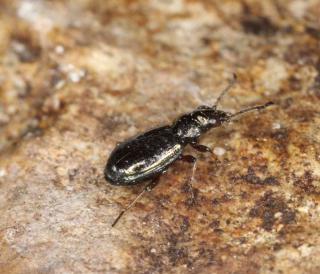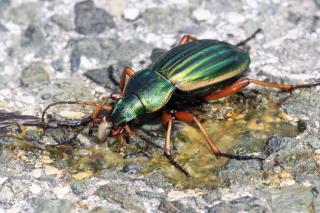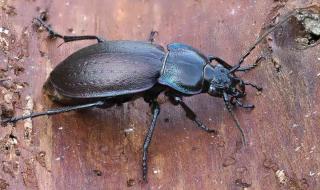

One of the most important beneficial insects in the garden is the ground beetle family. This fearsome predators have a voracious appetite which will certainly serve you well to control pests in your garden. Slugs and snails beware!
Read also:
The ground beetle group includes the largest ever species of the Carabidae family. Smaller beetles (there are many more of these) are often grouped under the more generic term “beetle”.
These ground-born beetle insects have a long and flat appearance. They have 3 pairs of legs, which makes them fast-moving hunters and their body has three distinct parts: abdomen, thorax and head. 
Even though some individual species have a pair of wings, not many carabids can actually fly. The larvae are fairly unique with their very thin, long body and 6 legs. Before turning into adults, they first go through a chrysalid stage which happens underground.
There are two types of reproduction cycles for ground beetles:
Each beetle can live several years. This long lifespan somewhat compensates the fact that they don’t reproduce prolifically.
Even though a few species are vegetarian, most of them are clearly carnivores. These very capable predators are able to catch and eat their weight in food every single day! Their diet is varied and they’ll hunt any of the following with gusto: slugs, snails, larvae, aphids, thrips, caterpillars, etc.
Even though they devour large amounts of food, ground beetles won’t be very effective at controlling an invasion of one specific pests such as aphids. Ladybug larvae or green lacewing will be much more targeted and effective. This notwithstanding, they nonetheless greatly help control pest populations in general. This is particularly true for insect species that overwinter on plants or in the leaf litter on the ground: this is the layer between the moist soil and the dry, dead leaves above. Plant materials in the litter layer are in advanced stages of decay.
Ground beetles may find refuge in many places: hedge, strip of grass, under flat stones, in piles of wood, etc.

Note that ground beetles are excellent to help control snails and slugs.
These beetle-like insects are extremely sensitive to changes in their environment. Since they live at ground level, any mechanical tool with rotating blades such as rototillers are apocalyptic calamities for them. Additionally, phytosanitary products might reduce or even completely eliminate this precious beneficial insects’ numbers. The solution is clear: if you want to help your six-footed friends, give them a habitat that is as natural as can be where the human hand only rarely intervenes:
 a charming wild hedge;
a charming wild hedge;Ground beetles are tireless predators, which make them a key help for gardeners. Even though they won’t single-handedly solve your pest problems, they’ll be of great help together with other options, and in any case the services they offer warrant their protection.
Did you know… ? Just like its cancellatus and Pterostichus cousins, the golden ground beetle also feeds on nefarious Colorado potato beetle larva. It is thus a valuable ally when growing potato, and must be particularly well taken care of. Indeed, this wingless species won’t spontaneously come back in a garden it has already disappeared from.